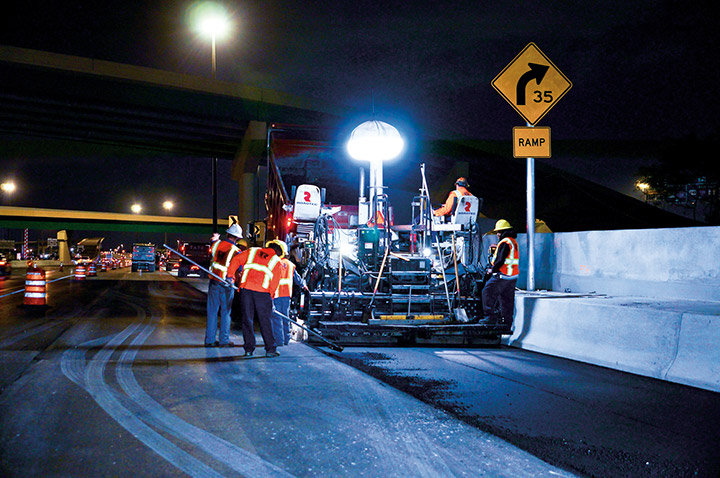Opening the Keys of Hot Mix Asphalt Technology
Discovering the midsts of warm mix asphalt modern technology reveals a world where careful processes and specific solutions merge to shape our roads and facilities. The combination of accumulations, fillers, and binders isn't simply a building job yet a strategic orchestration of resilience and performance. As we peer right into the elaborate dance of elements, a tapestry of durability and sustainability unravels. However what lies under this surface area of asphaltic proficiency, and what tricks wait to be unveiled in the realm of leading advancements?
Value of Hot Mix Asphalt
Warm Mix Asphalt plays a critical role in modern-day framework advancement because of its resilience and cost-effectiveness. As the most frequently utilized paving product for roads, highways, and car parking whole lots, Hot Mix Asphalt provides a series of benefits that add to its importance in building jobs. One key benefit is its capacity to withstand rush hour tons and extreme climate condition, providing a long-lasting and reputable surface area for transport networks. Furthermore, Hot Mix Asphalt is economical in both first building and long-term upkeep, making it a preferred option for several facilities projects.
The sturdiness of Hot Mix Asphalt comes from its make-up, that includes aggregates, binder, and filler materials that are very carefully chosen and mixed to meet specific efficiency needs. This exact combination results in a adaptable and solid sidewalk that can endure frequent use without considerable deterioration. Warm Mix Asphalt is 100% recyclable, more enhancing its sustainability and ecological advantages. On the whole, the significance of Warm Mix Asphalt in facilities advancement can not be understated, as it continues to be a keystone of modern construction methods.
Parts of Asphalt Mixes
The make-up of asphalt mixes consists of thoroughly chosen accumulations, binder, and filler materials that are vital for attaining specific efficiency needs. Aggregates are the primary part of asphalt mixes, offering strength and stability. These aggregates can be natural, such as crushed rock or crushed rock, or artificial, like recycled materials from old sidewalks. The binder, generally bitumen or asphalt cement, holds the aggregates with each other and offers flexibility and durability to the mix. The choice of the binder is critical as it directly influences the mix's efficiency in various weather problems. Fillers, such as moisturized lime or Rose city concrete, are utilized to boost the mix's workability and aging resistance. Angled Parking.
The combination and proportion of these parts play a considerable function in figuring out the high quality and efficiency of the asphalt mix. Designers thoroughly create the mix to fulfill particular needs, thinking about factors like website traffic quantity, climate problems, and sidewalk life expectancy. Appropriate selection and balancing of aggregates, binder, and fillers are necessary for developing durable, resilient asphalt sidewalks.
Mixing and Manufacturing Methods

When the accumulations are chosen, the binder, usually asphalt cement, is included to bind the products with each other. The binder's high quality and quantity substantially influence the mix's stamina, resistance, and versatility to ecological elements. In addition, fillers like hydrated lime or Portland cement may be incorporated to enhance certain attributes of the asphalt mix, such as its workability or wetness resistance.
During production, the aggregates and binder are warmed, generally in between 250-325 ° F(121-163 ° C ), to assist in blending and ensure proper finishing of the aggregates. The mixing process has to be thorough to achieve an uniform mix that advertises the wanted performance features of the asphalt. Different techniques, such as set blending or drum mixing, are utilized to accomplish constant and top quality asphalt blends for building projects.
Aspects Affecting Asphalt Efficiency
Elements influencing asphalt performance include a variety of variables that affect the longevity, long life, and general quality of asphalt sidewalks. One vital element is the high quality of products used in the asphalt mix. The type and resource of aggregates, the binder quality, and the additives all play a significant duty in identifying the performance of the asphalt pavement. The rank of aggregates is important as it impacts the mix's resistance, workability, and security to rutting and fracturing.

Layout factors to consider, such as sidewalk density and water drainage, are important in making sure the long-lasting efficiency of the asphalt pavement. By carefully considering these professionals, elements and engineers can enhance asphalt performance and boost the service life of pavements.
Sustainable Practices in Asphalt Innovation

WMA allows for the manufacturing and positioning of asphalt blends at reduced temperatures compared to conventional hot-mix asphalt, resulting in minimized energy usage and greenhouse gas exhausts. The use of porous asphalt blends can assist reduce stormwater drainage problems by allowing water to penetrate with the pavement and right into the ground, advertising all-natural water filtering and reenergize procedures.
Verdict
Finally, warm mix asphalt modern technology plays a crucial function in modern infrastructure growth because of its durability and cost-effectiveness. By carefully stabilizing components, employing correct blending strategies, and taking into consideration different factors, engineers can produce top notch asphalt blends that withstand hefty web traffic tons and rough climate condition. Welcoming lasting practices, such as utilizing warm-mix technologies and recycled products, better enhances the ecological friendliness of asphalt modern technology.
Blending and production techniques in warm mix asphalt innovation include the visit our website exact mix and handling of accumulations, binder, and fillers to produce a durable and high-performance asphalt mix.Factors influencing asphalt additional hints efficiency encompass a variety of variables that impact the sturdiness, long life, and overall quality of asphalt sidewalks. Lasting methods in asphalt technology include numerous efforts intended at minimizing the ecological effect of asphalt manufacturing and paving procedures. By integrating reclaimed asphalt sidewalk (RAP) and recycled asphalt shingles (RAS) into brand-new asphalt mixes, the industry can considerably minimize the intake of raw products and power, while also lowering land fill waste.
WMA enables for the manufacturing and positioning of asphalt mixes at reduced temperatures contrasted to conventional hot-mix asphalt, resulting in minimized power intake and greenhouse gas exhausts.